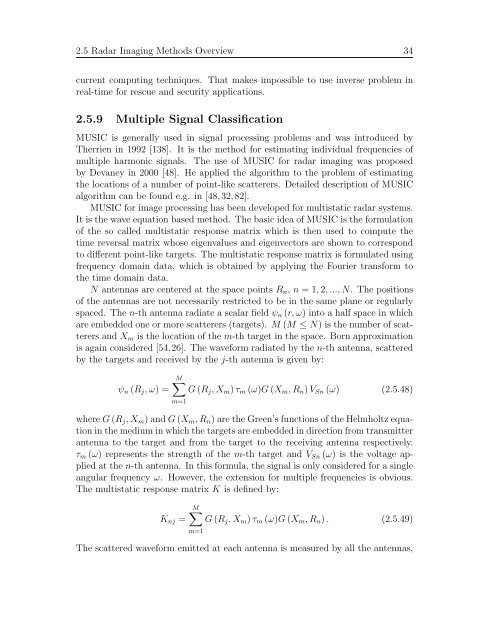Through-Wall Imaging With UWB Radar System - KEMT FEI TUKE
Through-Wall Imaging With UWB Radar System - KEMT FEI TUKE
Through-Wall Imaging With UWB Radar System - KEMT FEI TUKE
Create successful ePaper yourself
Turn your PDF publications into a flip-book with our unique Google optimized e-Paper software.
2.5 <strong>Radar</strong> <strong>Imaging</strong> Methods Overview 34<br />
current computing techniques. That makes impossible to use inverse problem in<br />
real-time for rescue and security applications.<br />
2.5.9 Multiple Signal Classification<br />
MUSIC is generally used in signal processing problems and was introduced by<br />
Therrien in 1992 [138]. It is the method for estimating individual frequencies of<br />
multiple harmonic signals. The use of MUSIC for radar imaging was proposed<br />
by Devaney in 2000 [48]. He applied the algorithm to the problem of estimating<br />
the locations of a number of point-like scatterers. Detailed description of MUSIC<br />
algorithm can be found e.g. in [48, 32, 82].<br />
MUSIC for image processing has been developed for multistatic radar systems.<br />
It is the wave equation based method. The basic idea of MUSIC is the formulation<br />
of the so called multistatic response matrix which is then used to compute the<br />
time reversal matrix whose eigenvalues and eigenvectors are shown to correspond<br />
to different point-like targets. The multistatic response matrix is formulated using<br />
frequency domain data, which is obtained by applying the Fourier transform to<br />
the time domain data.<br />
N antennas are centered at the space points Rn, n = 1, 2, ..., N. The positions<br />
of the antennas are not necessarily restricted to be in the same plane or regularly<br />
spaced. The n-th antenna radiate a scalar field ψn (r, ω) into a half space in which<br />
are embedded one or more scatterers (targets). M (M ≤ N) is the number of scatterers<br />
and Xm is the location of the m-th target in the space. Born approximation<br />
is again considered [54,26]. The waveform radiated by the n-th antenna, scattered<br />
by the targets and received by the j-th antenna is given by:<br />
ψn (Rj, ω) =<br />
M�<br />
G (Rj, Xm) τm (ω)G (Xm, Rn) VSn (ω) (2.5.48)<br />
m=1<br />
where G (Rj, Xm) and G (Xm, Rn) are the Green’s functions of the Helmholtz equation<br />
in the medium in which the targets are embedded in direction from transmitter<br />
antenna to the target and from the target to the receiving antenna respectively.<br />
τm (ω) represents the strength of the m-th target and VSn (ω) is the voltage applied<br />
at the n-th antenna. In this formula, the signal is only considered for a single<br />
angular frequency ω. However, the extension for multiple frequencies is obvious.<br />
The multistatic response matrix K is defined by:<br />
Knj =<br />
M�<br />
G (Rj, Xm) τm (ω)G (Xm, Rn) . (2.5.49)<br />
m=1<br />
The scattered waveform emitted at each antenna is measured by all the antennas,








